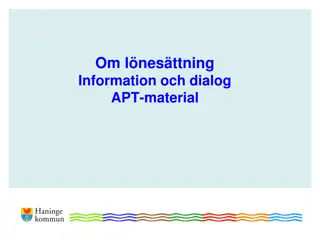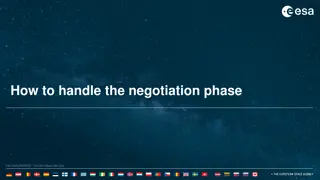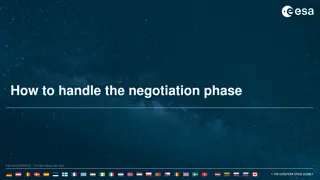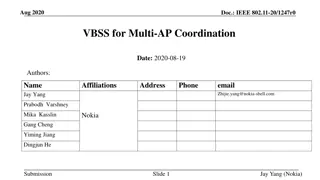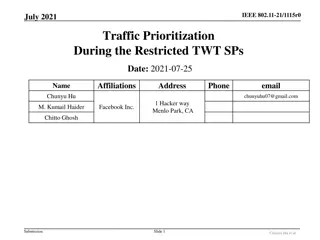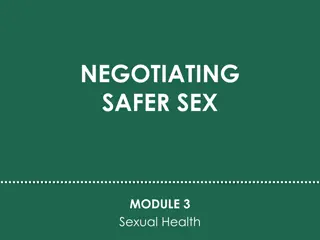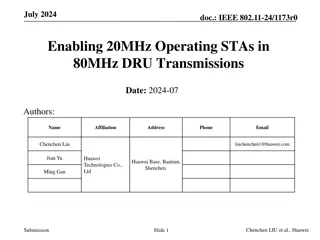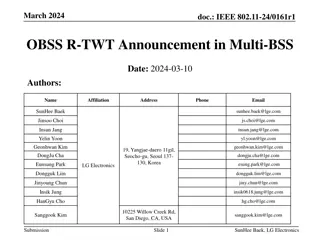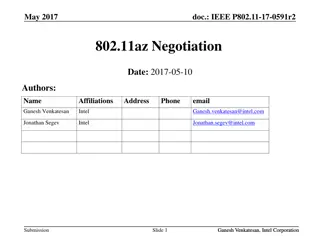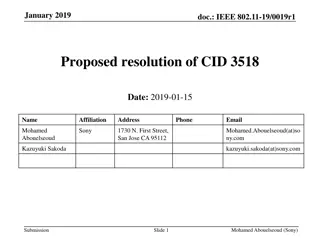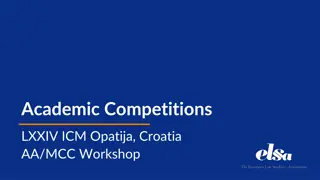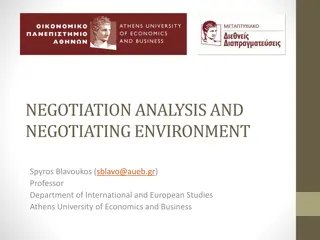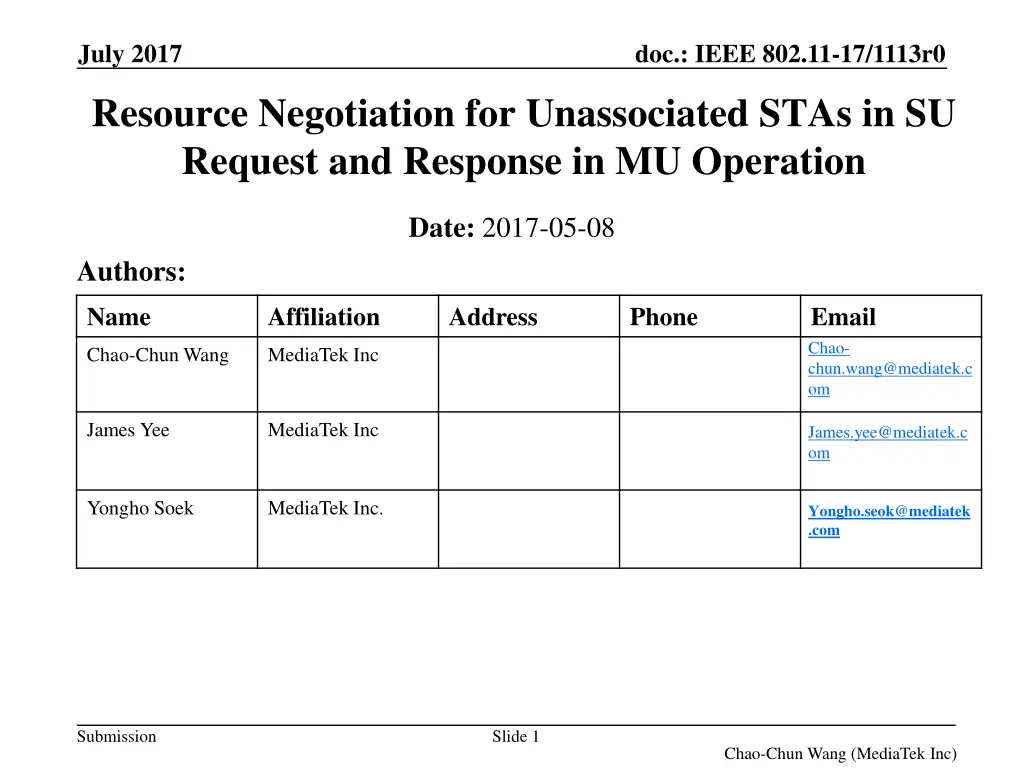
IEEE 802.11-17 Resource Negotiation for Unassociated STAs
Explore resource negotiation for unassociated STAs in SU and MU operation modes in IEEE 802.11-17 standard. Topics include protocol details, enterprise localization scenarios, and STAs behavior in AP environments.
Download Presentation

Please find below an Image/Link to download the presentation.
The content on the website is provided AS IS for your information and personal use only. It may not be sold, licensed, or shared on other websites without obtaining consent from the author. If you encounter any issues during the download, it is possible that the publisher has removed the file from their server.
You are allowed to download the files provided on this website for personal or commercial use, subject to the condition that they are used lawfully. All files are the property of their respective owners.
The content on the website is provided AS IS for your information and personal use only. It may not be sold, licensed, or shared on other websites without obtaining consent from the author.
E N D
Presentation Transcript
July 2017 doc.: IEEE 802.11-17/1113r0 Resource Negotiation for Unassociated STAs in SU Request and Response in MU Operation Date: 2017-05-08 Authors: Name Affiliation Address Phone Email Chao- chun.wang@mediatek.c om Chao-Chun Wang MediaTek Inc James Yee MediaTek Inc James.yee@mediatek.c om Yongho Soek MediaTek Inc. Yongho.seok@mediatek .com Submission Slide 1 Chao-Chun Wang (MediaTek Inc)
doc.: IEEE 802.11-17/1113r0 Background 0805r1 specifies the SU SU negotiation procedure in 11az Frame exchange sequence is the same as REVmc: FTM Request and Response frame types and formats needs to be updated, for example the response frame for unassociated STAs carry an ID (Ranging, Pre) and the NGP IE Resource negotiation for unassociated STAs in MU Operation is still Undecided. Unassociated STAs send request in SU mode and AP returns responses in MU mode Unassociated STAs send request in MU mode and AP returns responses in MU mode The contribution focus on the whether 11az shall support Unassociated STAs send request in SU mode and AP returns responses in MU mode Submission Slide 2 Chao-Chun Wang (MediaTek Inc)
July 2017 doc.: IEEE 802.11-17/1113r0 Recap (SU-MU) An STA sends FTM request in SU mode and receive FTM response (in SU PPDU format) for MU operation Do we need all protocol details before a decision can be made? Submission Slide 3 Chao-Chun Wang (MediaTek Inc)
July 2017 doc.: IEEE 802.11-17/1113r0 An Enterprise Locatioing Scenario An STA enters a large meeting venue/office space and moving/pacing through the area The STA associated with one ranging AP The SAT does not associated with any ranging APs The STA finds its location with first set of three or more APs The STA continues its movement and exiting the coverage area of one or more APs of the first set of APs and enters the coverage area of new APs The STA repeating the locationing operation in a constant interval to maintain its location information. Submission Slide 4 Chao-Chun Wang (MediaTek Inc)
July 2017 doc.: IEEE 802.11-17/1113r0 An Locationing STA s behavior An STA enters the coverage of three or more APs Case 1 - An STA sends ranging (FTM) request without listening to beacons. The STA has no idea about APs capability. The SAT does not associated with any ranging APs Case 1b - An STA sends ranging (FTM) request without listening to beacons but STA knows about the AP s ranging capabilities using mechanisms like Neighbor Report The STA associated with one ranging AP The STA receives neighboring ranging APs information via some means Case 2 - An STA sends ranging (FTM) request after receiving beacons from three or more APs. The STA knows about APs capability. How to guarantee that all STAs will behave as same. Others ? Submission Slide 5 Chao-Chun Wang (MediaTek Inc)
July 2017 doc.: IEEE 802.11-17/1113r0 Issues need to be addressed An STA sends FTM request in SU mode and receives FTM response (in SU PPDU format) for MU operation Does FTM Request has a field indicating the preference by the STA as to how it wants to receive FTM Response? The MU response frame (in SU PPDU) has a pre- defined/announced unique AID/multicast address to indicate that it is a FTM response frame An STA is expected to read all fields of the response frame with RA set to a pre-defined/announced multicast Address, The MU response frame (in SU PPDU) carries FTM parameters for every STAs including the Ranging ID assignment. The succeeding measurement operations operate in MU mode Submission Slide 6 Chao-Chun Wang (MediaTek Inc)
March 2017 doc.: IEEE 802.11-17/1113r0 More issues Power Consumption: The STA that has sent an SU request will be required to process all the frames or a limited number of frames to identified the response frame addressing all STAs send SU request Waiting time from transmitting FTM Request to Receiving FTM Response: Revmc has this value at 10msec Revmc has a value defined to allow for STAs to save power APs take time to process FTM Requests and allowing for a large number of requests can increase the waiting time for FTM Response(s) -> tradeoff to be addressed Using frames defined in 11ax or defining new frames to allow for 11az support Submission Slide 7 Chao-Chun Wang (MediaTek Inc.)
doc.: IEEE 802.11-17/1113r0 Straw Poll 1 11az Chao-Chun Wang, et al, MediaTek Submission Slide 8
doc.: IEEE 802.11-17/1113r0 Background Chao-Chun Wang, et al, MediaTek Submission Slide 9
May 2017 doc.: IEEE 802.11-17/1113r0 Background Recap 17/0463r1 discussed all possible mode of resource negation for unassociated STAs SU MU Y: 6 N: 0 A: 16 MU MU (mode 1) Y: 5 N: 1 A: 18 MU MU (mode 2) Y: 6 N: 0 A: 16 MU - MU (mode 2) Note: AP do explicitly ACK the FTM request frames. The ACK frame will carry ranging ID assignment for multiple requesters. Y: 1 N: 5 A: 17 The presentation is to clarify the SU-SU mode requirement Submission Slide 10 Chao-Chun Wang (MediaTek Inc)
May 2017 doc.: IEEE 802.11-17/1113r0 Mode of Operations - SU Motion Move to adopt the following text to the SFD under the section 3.2 and grant the editorial license to the SFD editor. The SU SU negotiation procedure in 11az shall have the following properities Frame exchange sequence is the same as REVmc: FTM Request and Response frame types and formats needs to be updated, for example the response frame for unassociated STAs carry an ID (Ranging, Pre) and the NGP IE. Mover : Chao-Chun Seconder : Edward AU Results: Y 16 N 0 Abs 0 Slide 11 Submission Chao-Chun Wang (MediaTek Inc)

